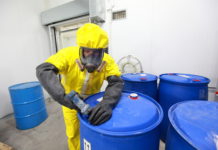While many people enjoy fresh raw oysters – raw shellfish (e.g. oysters, clams, mussels) can pose an increased risk to be contaminated – as they are filter feeders and become contaminated when their waters are polluted with raw sewage and bacteria.
Oysters can be contaminated with a variety of foodborne pathogens such as E. coli, norovirus, hepatitis A, and Vibrio vulnificus – which can put anyone at risk for infections.
August 5 is National Oyster Day! To ensure you’ll have shuckin’ good time – don’t gamble on your chances of getting sick with raw contaminated shellfish. Always eat cooked shellfish – i.e., by baking, grilling, or broiling.

- Learn about cross contamination, cold and hot food safety, best practices for personal hygiene, and foodborne illnesses.
- Food Manager ANSI Certification: SALE $99.00 - Valid in all States
- Food Handler ANSI Training for only $7.00!
- 10% OFF SALE: Enter Promo "TRAIN10OFF" at Checkout
Norovirus
Norovirus is a highly contagious virus that can cause viral gastroenteritis, often called “food poisoning” or the “stomach flu.” Eating raw or partially cooked shellfish can cause norovirus infection.
Norovirus makes its way into the marine environment through untreated human sewage (poop) and vomit. This may come from leaky septic systems, faulty waste water treatment plants, boaters, or beach-goers. Shellfish are filter feeders, which means they filter seawater through their bodies to get food floating in the water. When norovirus particles are in the water, shellfish can accumulate the virus in their bodies.
Vibrio and Vibriosis
About a dozen Vibrio species can cause human illness, known as vibriosis. The most common species causing human illness in the U.S. are Vibrio parahaemolyticus, Vibrio vulnificus, and Vibrio alginolyticus.
The CDC estimates 80,000 people become sick with vibriosis, and 100 people die from their infection, in the United States every year. Most of these illnesses happen from May through October when water temperatures are warmer. However, you can get sick from eating raw or undercooked oysters during any month of the year, and raw oysters from typically colder waters also can cause vibriosis.
Remember, you can’t tell if a raw oyster contains Vibrio germs from the way it looks, smells, or tastes. Always make sure oysters are fully cooked to stay safe from food poisoning.
Most Vibrio infections from oysters, such as Vibrio parahaemolyticus infection, result in only diarrhea and vomiting.
However, people with a Vibrio vulnificus infection can get very sick. Some people can even get infected through an open wound when swimming or wading in brackish or salt water.
This is because the infection can result in bloodstream infections, severe blistering skin lesions, and limb amputations. If you develop symptoms of vibriosis, tell your medical provider if you recently ate or handled raw shellfish.
Anyone can get sick from vibriosis, but you may be more likely to get an infection or severe complications if you:
- Have liver disease, alcoholism, cancer, diabetes, HIV, or thalassemia.
- Receive immune-suppressing therapy for the treatment of disease, such as for cancer.
- Have an iron overload disease, such as hemochromatosis.
- Take medicine to lower stomach acid levels, such as Nexium and Pepcid.
- Have had recent stomach surgery.
How can I stay safe?
Follow these tips to reduce your chances of getting an infection when eating or handling shellfish and other seafood:
- Don’t eat raw or undercooked oysters or other shellfish. Fully cook them before eating, and only order fully cooked oysters at restaurants. Hot sauce and lemon juice don’t kill Vibrio bacteria and neither does alcohol.
- Some oysters are treated for safety after they are harvested. This treatment can reduce levels of vibrios in the oyster but it does not remove all harmful germs. People who are more likely to get vibriosis should not eat any raw oysters.
- Separate cooked seafood from raw seafood and its juices to avoid cross contamination.
- Wash your hands with soap and water after handing raw seafood.
- Cover any wounds if they could come into contact with raw seafood or raw seafood juices or with brackish or salt water.
- Wash open wounds and cuts thoroughly with soap and water if they have been exposed to seawater or raw seafood or its juices.

Safety Tips for Cooking Shellfish
Before cooking, throw out any shellfish with open shells.
For oysters in the shell, either:
- Boil until the shells open and continue boiling 3–5 more minutes, or
- Steam until the shells open and continue steaming for 4–9 more minutes.
- Only eat shellfish that open during cooking. Throw out shellfish that do not open fully after cooking.
For shucked oysters, either:
- Boil for at least 3 minutes or until edges curl;
- Fry for at least 3 minutes at 375°F;
- Broil 3 inches from heat for 3 minutes; or
- Bake at 450° F for 10 minutes.

Additional information
- Take a look at CDC’s questions and answers about Vibrio and vibriosis
- Listen to CDC podcast on the dangers of eating raw oysters
- Be food safe – learn how you can protect yourself from food poisoning
- Read more guidance on FoodSafety.gov for preventing Vibrio infections
- Learn more about aquaculture: http://www.fisheries.noaa.gov/aquaculture/index.htm
- Learn more about Pacific and Eastern oysters from FishWatch: http://www.fishwatch.gov/profiles/search/oyster


























